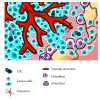Osteosarcoma: Cells-of-Origin, Cancer Stem Cells, and Targeted Therapies
- PMID: 27366153
- PMCID: PMC4913005
- DOI: 10.1155/2016/3631764
Osteosarcoma: Cells-of-Origin, Cancer Stem Cells, and Targeted Therapies
Abstract
Osteosarcoma (OS) is the most common type of primary solid tumor that develops in bone. Although standard chemotherapy has significantly improved long-term survival over the past few decades, the outcome for those patients with metastatic or recurrent OS remains dismally poor and, therefore, novel agents and treatment regimens are urgently required. A hypothesis to explain the resistance of OS to chemotherapy is the existence of drug resistant CSCs with progenitor properties that are responsible of tumor relapses and metastasis. These subpopulations of CSCs commonly emerge during tumor evolution from the cell-of-origin, which are the normal cells that acquire the first cancer-promoting mutations to initiate tumor formation. In OS, several cell types along the osteogenic lineage have been proposed as cell-of-origin. Both the cell-of-origin and their derived CSC subpopulations are highly influenced by environmental and epigenetic factors and, therefore, targeting the OS-CSC environment and niche is the rationale for many recently postulated therapies. Likewise, some strategies for targeting CSC-associated signaling pathways have already been tested in both preclinical and clinical settings. This review recapitulates current OS cell-of-origin models, the properties of the OS-CSC and its niche, and potential new therapies able to target OS-CSCs.
Figures


References
-
- Rosenberg A. E., Cleton-Jansen A. M., de Pinieux G., et al. Conventional osteosarcoma. In: Fletcher C. D. M., Bridge J. A., Hogendoorn P. C. W., Mertens F., editors. WHO Classification of Tumours of Soft Tissue and Bone. 4th. Lyon, France: International Agency for Research on Cancer; 2013. pp. 282–288.
Publication types
LinkOut - more resources
Full Text Sources
Other Literature Sources
Medical
Miscellaneous

